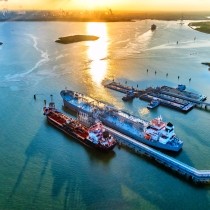
Case Study | May 2025
Executive Development in the Oil and Gas Industry
How a growth-focused O&G company future-proofed its leadership by aligning executive development with strategic M&A goals, and paved the way for internal CEO succession and long-term talent sustainability.
The Company
The company is a mid-sized public company in the Oil and Gas (O&G) industry, headquartered in the US. It has about 5,000 employees and more than $2B in revenue.
The Leadership Challenge and Strategic Approach
The company was well known for its strong performance in core product offerings and sought to expand its portfolio through a significant acquisition of a top player in an adjacent sector. The board had issued a mandate to accelerate inorganic growth as the external environment revealed the need to diversify beyond its core product, despite consistent year-over-year results. Further, there was increased attention on retaining and developing internal talent as the external talent market had become increasingly difficult.
While many companies struggle with development and retention, those in oil and gas have additional concerns. Factors including the potential for prolonged downturns within the cyclical O&G industry and the perception of environmental impacts have led to fewer people entering the industry and some with transferable skills (e.g., IT, finance, and HR) have left. The result is a lack of 20- to 25-year tenured leaders who would normally become the pool for executive talent. Additionally, within the broader energy sector, there is a tendency toward very strong corporate cultures with an “us against the world” mindset that makes it difficult to quickly plug in outside recruits. Taken together, these factors increase the need and urgency to develop new executives from the internal pool when possible.
Though the CEO's succession plan was not yet in place nor on the near-term horizon, the board, in partnership with the CEO, recognized the need to prepare the organization for future success. Their collective goal was to ensure that the current leadership team could execute the strategic shift toward M&A as mandated by the board, both in the immediate term and over the longer-term horizon, presumably under the CEO’s successor.
While the executive team had been effective in managing the organization’s operations to date and driving the existing business strategy, discussions among the board and CEO revealed a significant gap: The organization lacked a clear understanding of the skills, capabilities, and experiences required to lead successfully in the future.
The board concluded that external expertise was needed to first develop a comprehensive “future leadership profile.” Then the current C-suite could be assessed against it, and targeted development opportunities for key executives could be outlined. The central aim was to answer four pivotal questions: What capabilities will leaders need to drive the organization forward? Who possesses these skills today? How can we develop the necessary competencies in our leadership team? And how are our leaders going to address the difficult external talent market in our industry?
The Solution
The process began with a leadership consulting team that conducted in-depth interviews with the board and senior executives to define the key attributes and experiences required for leadership in the organization’s evolving context. This surfaced capabilities like strategic agility, risk management, talent development, and enhanced personal resilience and adaptability, among other essential qualities. Based on these interviews and further discussions, the consultants then worked closely with the CEO and the CHRO to identify the three most likely internal CEO succession candidates. They also selected two additional executives for inclusion in the assessment and development process.
The next phase involved a year-long, highly personalized leadership development program. This began with a comprehensive 360-degree assessment for each selected executive against the future leadership profile, combined with development planning and one-on-one executive coaching. The aim was to provide an honest and holistic view of their strengths and areas for growth.
For the three CEO succession candidates, a tailored development program was designed to address the specific gaps identified in their assessments. This bespoke program was aligned with the long-term strategic goals of the organization and included a mix of targeted on-the-job stretch assignments aimed at addressing business challenges; skill-building in critical areas such as public speaking and executive communications; and ongoing one-on-one coaching to refine leadership capabilities. Examples of ongoing coaching topics included cross-functional collaboration, leadership presence, influence without authority, and agile stakeholder engagement.
Results
The results of the engagement were both immediate and long-term, with several key outcomes that have positioned the organization for continued success.
Increased Self-Awareness: Executives gained a deeper understanding of their leadership styles and the impact of their behaviors on others. They demonstrated heightened vulnerability in seeking developmental feedback from peers, direct reports, and cross-functional teams. As a result, the executive team meetings are more transparent/efficient, there is increased bench strength further in the organization, and an increase in cross-functional collaboration.
Strategic Succession Planning: For the board, the creation of the future leadership profile and the assessment of executives provided invaluable insights into the organization’s leadership pipeline. This increased visibility into potential future leaders will help the board enact a smoother CEO transition when the time comes—whether that is with an internally identified and developed executive (the preferred outcome) or if there is a need to look external for specific leadership characteristics—and will be a sustainable process moving forward.
Ongoing Talent Management Dialogue: Perhaps most significantly, the initiative catalyzed an ongoing, productive conversation between the board and the CEO about talent management—a critical dialogue that had previously been lacking. This ensures that leadership development will be aligned with the organization’s long-term strategy and will evolve with future business needs.



